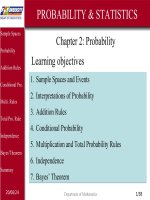Continuous Probability Distributions
Bạn đang xem bản rút gọn của tài liệu. Xem và tải ngay bản đầy đủ của tài liệu tại đây (2.9 MB, 122 trang )
Chapter 7
Continuous Probability
Distributions
1
7.1 Probability Density Function
A continuous random variable has an
uncountable infinite number of values in the
interval (a,b).
To calculate probabilities of continuous random
variables we define a probability density function
f(x), which satisfies the following conditions
Area = 1
– f(x) is non-negative,
– The total area under the curve
representing f(x) is equal to 1.
2
The probability that a continuous variable X will assume
any particular value is zero.
The probability that x falls between ‘a’ and ‘b’ is the area
under the graph of f(x) between ‘a’ and ‘b’.
P(a≤ x≤ b)
a
b
3
Uniform Distribution
A random variable X is said to be uniformly
distributed if its density function
is
1
f ( x) =
with
b−a
a+b
E(X) =
2
f(X)
a
b
a ≤ x ≤ b.
(b − a) 2
V(X ) =
12
X
4
Example 7.1: The daily sale of gasoline is uniformly
distributed between 2,000 and 5,000 gallons. Find the
probability that sales are: Between 2,500 and 3,000 gallons
P(2500≤ X≤ 3000) = (3000-2500)(1/3000) = .1667
1/3000
2000 2500 3000
5000
x
5
7.2 Normal Distribution
A random variable X with mean µ and variance σ 2 is normally distributed if its probability density function is
We denote a normal distribution by N(µ, σ 2 ) .
Normal distributions range from minus infinity to plus infinity
2
x
−
µ
x
−
µ
−−(1(1/ /22)) σ
σ
e
2
1
1
∞≤≤ xx≤≤∞
∞
ff((xx))==
e
−−∞
σσ 22ππ
where ππ==33..14159
14159...... and
and ee ==22..71828
71828......
where
6
The Shape of the Normal Distribution
µ
bell shaped, and symmetrical around µ.
7
Increasing the mean shifts the curve to
the right…
8.8
Increasing the standard deviation “flattens” the
curve…
8.9
Two facts help calculate normal probabilities:
-
The normal distribution is symmetrical.
2
Any random variable (rv) X having N(µ , σ ) can be transformed into a rv Z having
N(0 , 1 ) , called the
“STANDARD NORMAL DISTRIBUTION”
or the Z-distribution by
X −− µµ
X
ZZ ==
σσ
10
We can use the following function to convert any normal random variable to a standard
normal random variable:
0
Some advice: always
draw a picture!
8.11
The “standard normal distribution” or the Zdistribution N(0,1)
This shifts the
mean of X to zero…
0
8.12
0
This changes the
shape of the curve…
8.13
Example 1: The amount of time it takes to
assemble a computer is normally distributed, with
a mean of 50 minutes and a standard deviation of
10 minutes. What is the probability that a
computer is assembled in between 45 and 60
minutes?
•Solution
Let X denote the assembly time of a computer.
We seek P(45
45 - 50
P(45
10
X− µ
60 - 50
<
)
σ
10
(45-50)/10 = -.5
(60 – 50)/10 = 1
= P(-0.5
To complete the
calculation we need to
compute
the probability under the
standard normal
distribution
z0 = -.5
z0 = 1
The
probability
provided by
the Z-Table
covers the
area
between
‘-infinity’
and some
‘z0’.
z0
16
Using the Normal Table, or the Z table
P(-.5
.3413
0
17
Example 2: The rate of return (X) on an investment is normally
distributed with mean of 10% and standard deviation of 5%.
What is the probability of losing money?
Solution
Money is lost if the
return is negative
0%
10%
X
P(X< 0 ) = P(Z< 0 - 10 ) = P(Z< - 2) = .0228
5
18
Example 2: The standard deviation of the rate of return (X) is
now 10%. What is the probability of losing money?
The curve for σ =5%
The curve for σ = 10%
X
0%
P(X< 0 ) = P(Z<
10%
0 - 10
)=
10
P(Z< - 1) = .1587
Comment: When the standard deviation is 10% rather than
5%, more values fall away from the mean, so the probability
of finding values at the distribution tail increases from .0228
to .1587.
Z
19
Using Excel to Find Normal Probabilities
For P(X
Example: Let m = 50 and s = 10.
P(X < 30): =normdist(30,50,10,True)
P(X > 45): =1 - normdist(45,50,10,True)
P(30
Using “normsdist” if the “Z” value is known
P(Z<1.2234): =normsdist(1.2234)
20
Finding Values of Z
Sometimes we need to find the value of Z for a
given probability
We use the notation zA to express a Z value for
which P(Z > zA) = A
A
zA
21
Example 3:
What percentage of N(0,1) the standard normal population is located to the right of z .10?
Answer: 10%
A = .10
z.10
What percentage of the standard normal population
is located to the left of z.30?
Answer: 70%
1 – A = .70
A = .30
z.30
What percentage of the standard normal population is located between z .95 and
z.40:
55%
Comment: z.95 has a negative value
A1 = .95
A2 = .40
z.95
z.40
Example 4: Determine z not exceeded by 5% of
the population; that is, z is exceeded by 95% of
the population.
Solution: Because of the symmetry of the normal
distribution it is the negative value of z.05.
0.05
-1.645
0.95
-Z0.05
0
Z0.05
1.645
23
7.5 Other Continuous Distribution
Student t-distribution
Chi-squared distribution
F distribution
24
The Student t density function
− ( ν +1) / 2
22 − ( ν +1) / 2
[(νν−−11)]!
)]! tt
[(
1
+
ff((tt))==
1
+
νπ[([(νν−−22)]!
)]! νν
νπ
ν (nu) is called the degrees of freedom
E(t) = 0
V(t) = n/(n – 2)
(for n > 2)
25









